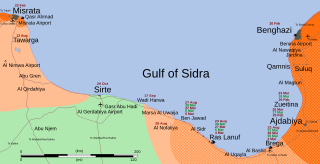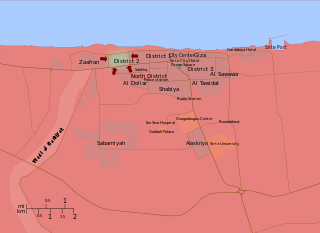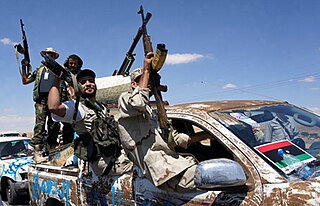Tawergha, also transliterated Tawargha, Tawarga, Tauorga, Taworgha, Tawurgha or Torghae, is, as of May 2021, a former ghost town in Libya that is under administrative jurisdiction of the city of Misrata, which is 38 kilometers away. It was the site of intense fighting during the Libyan Civil War before it was captured and forcibly evacuated by anti-Gaddafi forces in August 2011.

Abu-Bakr Yunis Jabr was a Libyan military officer and politician was the Libyan Secretary of the Libyan General Committee for Defence during the rule of Muammar Gaddafi. His official position was Secretary of the Libyan General Interim Committee for Defence.

The battle of Misrata, also known as the siege of Misrata, was a battle of the 2011 Libyan Civil War for the control of Misrata. It was fought between troops loyal to the government of Muammar Gaddafi, and anti-Gaddafi rebels who held Misrata, the third largest city in Libya. Following the initial stages of the uprising, the Libyan government took back most towns in the west of the country, leaving Misrata the only major city under rebel control in Tripolitania. The city soon became the site of one of the war's major battles and the suffering of its citizens gained worldwide attention.

The Libyan Civil War began on 17 February 2011 as a civil protest and later evolved into a widespread uprising. By mid-August, anti-Gaddafi forces effectively supported by a NATO-led international coalition were ascendant in Tripolitania, breaking out of the restive Nafusa Mountains in the south to mount an offensive toward the coast and advancing from Misrata on loyalist-held cities and villages from the north and east.
The Third Battle of Brega was fought during the Libyan Civil War between government forces and anti-Gaddafi forces for control of the town of Brega and its surroundings.

The First Gulf of Sidra offensive was the second major rebel offensive of the Libyan Civil War. It was mounted by anti-Gaddafi forces immediately after their victory in the Battle of Ajdabiya. The offensive was meant to have the rebel forces quickly reach Gaddafi's hometown of Sirte.
The Fourth Battle of Brega was a battle during the Libyan Civil War between forces loyal to Muammar Gaddafi and forces of the Libyan opposition for control of the strategic town of Brega and its oil port.

Moussa Ibrahim Gaddafi is a Libyan political figure who rose to international attention in 2011 as Muammar Gaddafi's Information Minister and official spokesman, serving in this role until the government was toppled in the Libyan Civil War. Ibrahim held frequent press conferences in the course of the war, denouncing rebel forces and the NATO-led military intervention, often in defiant and impassioned tones. His status and whereabouts remained unknown following the Battle of Tripoli in which the Gaddafi government was overthrown, although there were several claims and subsequent refutations of his capture. Eventually, in late 2014, it was discovered he was in Egypt before he was deported and fled to Serbia. On 12 January 2015 Moussa Ibrahim spoke publicly by video link at a political event hosted at the Committee Rooms Houses of Parliament, Westminster, London from an undisclosed location, also the Director of Private Security Company.
The Nafusa Mountains campaign was a series of battles in the Libyan Civil War, fought between loyalist pro-Gaddafi forces and rebel anti-Gaddafi forces in the Nafusa Mountains and, at a later period, in the surrounding plains of western Libya. The mountain range is of strategic importance due to its close proximity to the capital of Tripoli. Along with the city of Misrata, the Nafusa Mountains region was one of the major rebel strongholds in Tripolitania.
The Battle of Brega–Ajdabiya road was a battle during the Libyan Civil War between forces loyal to Libyan leader Muammar Gaddafi and anti-Gaddafi forces for control of the towns of Brega and Ajdabiya respectively and the Libyan Coastal Highway between them.
The Battle of the Misrata frontline was a battle during the Libyan Civil War between pro-Gaddafi loyalists and anti-Gaddafi forces on the western and southwestern outskirts of Misrata, the third largest city in Libya. It ended when anti-Gaddafi soldiers secured Zliten to the west and Tawergha to the south, establishing a significant buffer zone around the city.
The Second Battle of Zawiya or Zawia took place during the Libyan Civil War between rebel anti-Gaddafi forces and forces loyal to Muammar Gaddafi for control of the Tripolitanian city of Zawia.
The Battle of Zliten followed an unsuccessful uprising in Zliten, Libya, during the Libyan Civil War. It began on 21 July 2011 when elements of the National Liberation Army, part of the anti-Gaddafi forces seeking to overthrow the government of Muammar Gaddafi, moved into the city of Zliten after struggling over the course of the past several months to extend the frontline westward from Misrata, the second-largest city in rebel hands.

The timeline of the Libyan civil war begins on 15 February 2011 and ends on 20 October 2011. The conflict began with a series of peaceful protests, similar to others of the Arab Spring, later becoming a full-scale civil war between the forces loyal to Muammar Gaddafi's government and the anti-Gaddafi forces. The conflict can roughly be divided into two periods before and after external military intervention authorized by United Nations Security Council Resolution 1973.

The Battle of Tripoli, sometimes referred to as the Fall of Tripoli, was a military confrontation in Tripoli, Libya, between loyalists of Muammar Gaddafi, the longtime leader of Libya, and the National Transitional Council, which was attempting to overthrow Gaddafi and take control of the capital. The battle began on 20 August 2011, six months after the First Libyan Civil War started, with an uprising within the city; rebel forces outside the city planned an offensive to link up with elements within Tripoli, and eventually take control of the nation's capital.

The Libyan Civil War began on 15 February 2011 as a civil protest and later evolved into a widespread uprising. However, by 19 March, Libyan forces under Colonel Muammar Gaddafi were on the brink of a decisive victory over rebels in Libya's east. That day, leading NATO members acted on United Nations Security Council Resolution 1973 which authorized member states "to take all necessary measures... to protect civilians and civilian populated areas under threat of attack in the Libyan Arab Jamahiriya, including Benghazi, while excluding an occupation force".

The Second Gulf of Sidra offensive was a military operation in the First Libyan Civil War conducted by rebel anti-Gaddafi forces in August and September 2011 to take control of towns along the Gulf of Sidra in an effort to surround Muammar Gaddafi's hometown of Sirte, which was held by pro-Gaddafi forces. It ended on 20 October, with the capture and execution of Muammar Gaddafi and his son Mutassim Gaddafi, along with former defense minister Abu-Bakr Yunis Jabr. The Gaddafi loyalists in the area were finally defeated when NTC fighters captured Sirte.

The Battle of Sirte was the final and most decisive battle of the First Libyan Civil War, beginning when the National Liberation Army attacked the last remnants of the Libyan army still loyal to Muammar Gaddafi in his hometown and designated capital of Sirte, on the Gulf of Sidra. As of September 2011, Sirte and Bani Walid were the last strongholds of Gaddafi loyalists and the National Transitional Council hoped that the fall of Sirte would bring the war to an end. The battle and its aftermath marked the final collapse of the four-decade Gaddafi regime. Both Gaddafi and his son, Mutassim, were wounded and captured, then tortured and killed in custody less than an hour later. The month-long battle left Sirte almost completely in ruins, with many buildings damaged or totally destroyed.

The Battle of Bani Walid was a military operation in the Libyan Civil War conducted by anti-Gaddafi forces in September and October 2011, in an effort to take control of the desert city of Bani Walid from pro-Gaddafi forces. It began following days of force buildup on the part of the attackers, as well as skirmishes around the city.

The 2011 Libyan Civil War began on 17 February 2011 as a civil protest and later evolved into a widespread uprising. After a military intervention led by France, the United Kingdom, and the United States on 19 March turned the tide of the conflict at the Second Battle of Benghazi, anti-Gaddafi forces regrouped and established control over Misrata and most of the Nafusa Mountains in Tripolitania and much of the eastern region of Cyrenaica. In mid-May, they finally broke an extended siege of Misrata.








